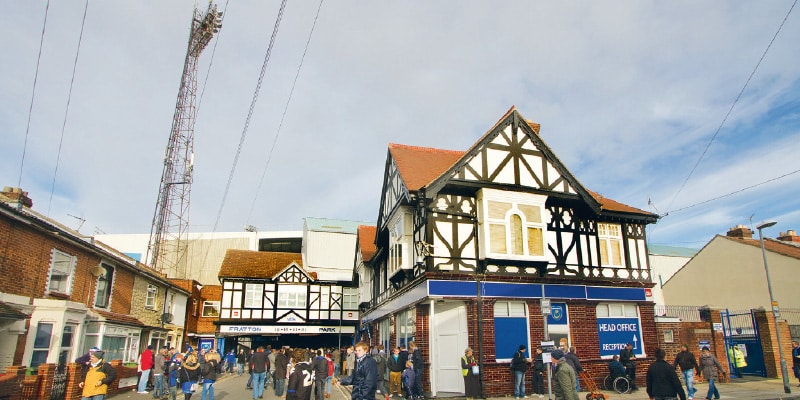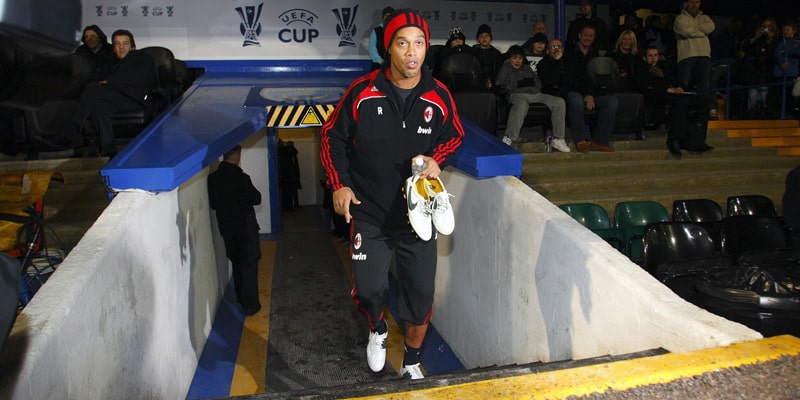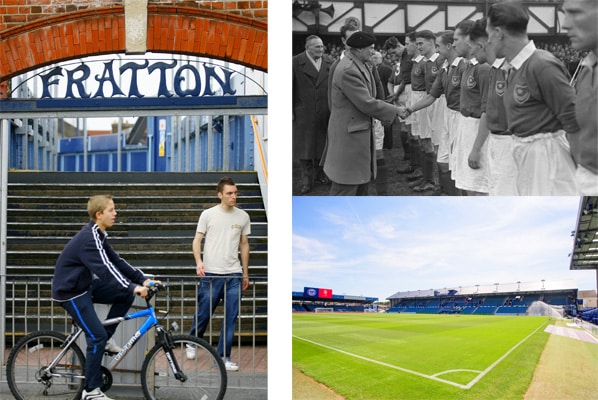
The Pompey pub club offices and matching clubhouse, with its mock-Tudor frontage, at Fratton Park. Colin McPherson/WSC Photos
For 125 years, opposition players and managers have left the Archibald Leitch-designed south coast stadium with the Pompey Chimes ringing in their ears
By Colin Farmery
2 January 2023
“The best atmosphere in world football.” Not my words, but those of Ronaldinho. The Milan striker was speaking after his team’s fortunate 2-2 draw at Fratton Park in November 2008, in Pompey’s only proper European campaign – if you don’t count the Anglo-Italian Cup, that is.
Pinning down exactly where and when those precise words were uttered is not an easy task and, thus far, beyond me, but never let the facts get in the way of a good urban myth. Besides, he’s not the only football A-lister to be seduced: for José Mourinho it was “absolutely incredible”, while Thierry Henry declared “it was amazing”. Even Ralph Hassenhüttl, then manager of bitter rivals Southampton, was moved after his side’s 4-0 League Cup win in 2019 to say: “I have never had such an atmosphere in a stadium so far and I have seen a lot…”

Ronaldinho emerges from the tunnel to sample Fratton Park’s atmosphere. Alamy
In April 2023 Pompey will celebrate their 125th anniversary and Fratton Park has been with them every step of the way. Ironically, it’s not in Fratton at all. The savvy businessmen who met at 12 High Street on April 5, 1898 to form the club decided to name the four and a half acres of market garden land they’d purchased after the nearest station half a mile away. The club’s agricultural roots are confirmed in their cash book, which gives the first transaction as £16 8/- received for a load of potatoes dug up from a field.
In roughly six months the land was drained and levelled, enclosed and two stands built on the south and north sides. Earth banking provided elevated viewing and on September 9, 1899 around 9,000 people saw the first proper game there. A financial crisis in 1912 aside, Pompey’s trajectory was upward and Fratton Park expanded accordingly. The Pompey pub, now housing club offices, was built in 1901 and in 1905 the matching clubhouse, with its iconic mock-Tudor frontage, was added.
By the 1920s Pompey were in the Football League and in 1924, now in the second division, the ambitious board commissioned architect Archibald Leitch to design a new South Stand. Work started in April 1925 and League president Joseph McKenna formally opened it in August. With its backlit roof panels and trademark latticework frontage, it was one of the foremost stands in England. The fact it backed onto the gardens of the houses in Carisbrooke Road would be a constraining factor for future generations.
In 1934, Leitch was commissioned again. The more functional North Stand, paid for with the £10,500 from Jimmy Allen’s transfer to Aston Villa, took the nominal capacity to 60,000. With the concrete terrace on the Milton End dating from the late 1920s, the essential fabric of three-quarters of Fratton Park to this day was complete.

The entrance to Fratton station, after which Portsmouth’s stadium was named; Portsmouth players line up before a game in front of Archibald Leitch’s South Stand to shake hands with club president Field Marshal Montgomery; the newly renovated stand. Alamy, Getty Images (2)
The stadium’s capacity was revised to 52,000 after the Burnden Park tragedy in 1946, but it was tested as Pompey laid to waste all before them in 1949 and 1950, champions of England twice in succession. A two-tiered concrete terrace at the Fratton End was built in 1956, but it would become a symbol of decline. Built with aggregate dredged from the Solent, salt corroded the metal reinforcements and its upper tier was condemned just 30 years later, by which time Pompey had settled in the second via divisions three and four.
The nadir came in 1996, with capacity reduced to 7,000 seats as the post-Taylor Report requirements kicked in. One positive of the brief Terry Venables era which followed was the building of the new 4,500-seat Fratton End in 1997, which remains the beating heart of the ground.
Plans to move have come and gone, with Fratton Park allowed to deteriorate in the meantime. Successive owners’ grandiose ambitions foundered on the rock of financial mismanagement. Community ownership steadied the ship in 2013 and cleared the backlog of planned maintenance, preventing the capacity becoming unviable.
The arrival of Michael Eisner as owner in 2017 has seen more root-and-branch investment. The North and South Stands have been sensitively restored, with Leitch’s latticework revealed again after being lost to hasty post-Bradford fire revisions in 1985, and work on the Milton End is underway. With the best part of £20 million committed, Fratton Park is set to be our home for the foreseeable future, proving there’s perhaps life yet in the old-school football ground.
Colin Farmery is chair of the Pompey History Society and editor of the recently published book Pompey: Champions of England
This article first appeared in WSC 427, January 2023. Subscribers get free access to the complete WSC digital archive
Want to see your writing published in WSC? Take a look at our pitching guide and get in touch
Tags: Fratton Park, Portsmouth, Stadiums, Team Spirit
